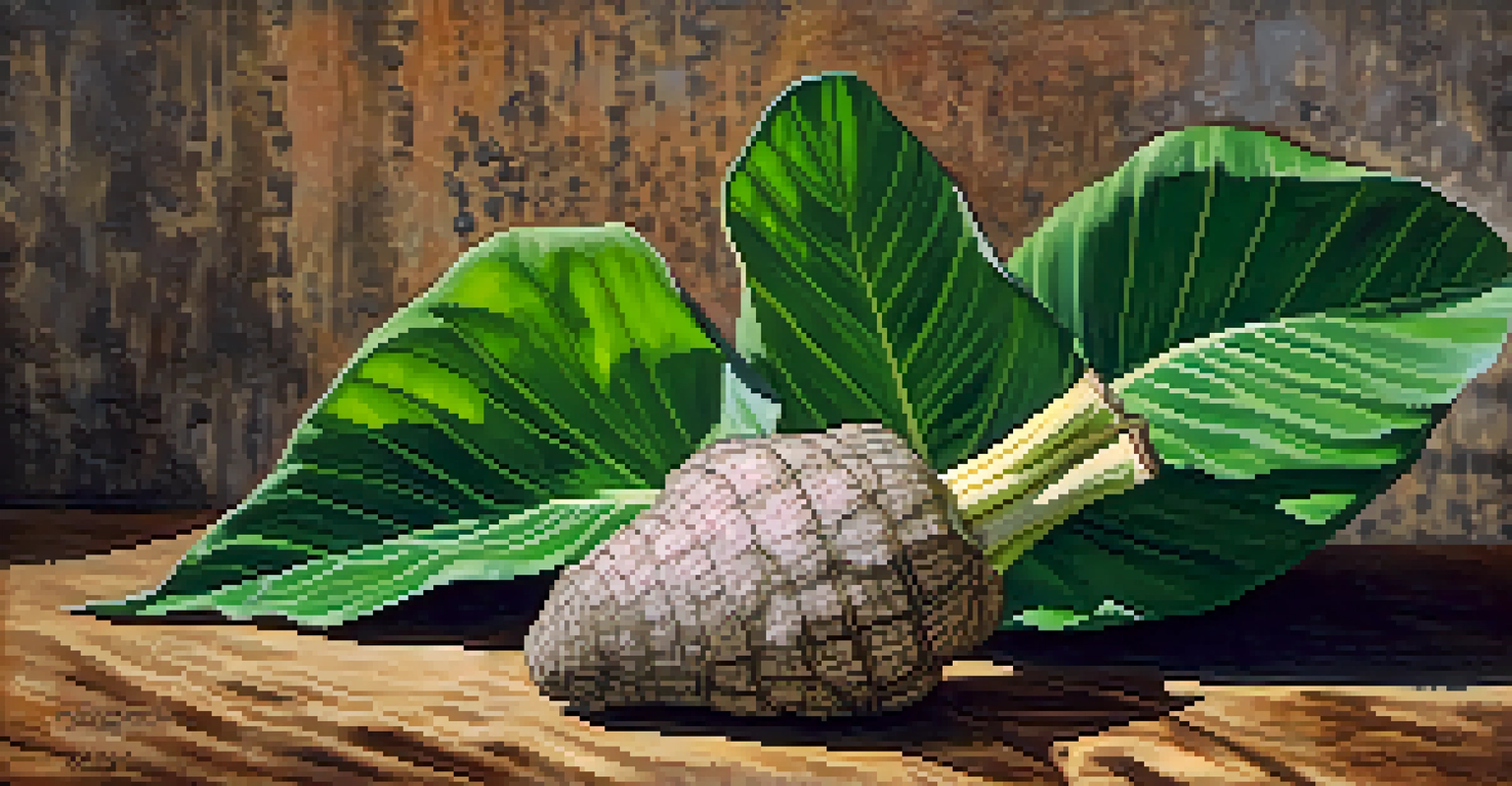A Taste of Aloha: Unique Ingredients in Hawaiian Cooking

The Essence of Aloha: An Overview of Hawaiian Cuisine
Hawaiian cuisine is a beautiful blend of flavors, cultures, and traditions. It's a culinary journey that reflects the islands' rich history, influenced by Polynesian, Asian, and European settlers. This melting pot of cultures has given rise to a unique food scene that captures the essence of aloha—a spirit of love and hospitality.
Food is a central part of Hawaiian culture, reflecting the islands' rich history and the spirit of aloha.
At its core, Hawaiian cooking emphasizes fresh, local ingredients that celebrate the lush, tropical environment. It's not just about the food; it's about the experience, the gatherings, and the storytelling that often accompany each meal. Each dish tells a story, embodying the spirit of the islands and their people.
From the vibrant colors of fresh produce to the rich flavors of marinated meats, Hawaiian cuisine has something for everyone. Whether you're a local or a visitor, embracing these unique ingredients can lead to a deeper appreciation of the islands' culture and heritage.
Taro: The Heartbeat of Hawaiian Cooking
Taro, known as kalo in Hawaiian, is a staple ingredient that's deeply rooted in the islands' history. It's not just a vegetable; it's a symbol of life, family, and sustainability. Traditionally, taro is used to make poi, a smooth paste that pairs perfectly with various dishes.

The cultivation of taro is a labor of love, often done in loʻi, or taro patches, that rely on ancient Hawaiian irrigation systems. This method reflects the deep respect Hawaiians have for the land and its resources. The flavor of taro is subtle yet earthy, making it a versatile base for both savory and sweet dishes.
Hawaiian Cuisine Reflects Cultural Richness
Hawaiian cuisine is a unique blend of flavors influenced by various cultures, emphasizing fresh, local ingredients and the spirit of aloha.
In addition to poi, taro leaves are also used in dishes like laulau, where they envelop meats and are steamed to perfection. This connection to the land and its produce showcases the importance of taro in Hawaiian cuisine, nourishing both body and spirit.
Sweet and Savory: The Magic of Pineapple
Pineapple is perhaps one of the most iconic symbols of Hawaiian cuisine, embodying the sweet, tropical flavors that the islands are known for. It’s not just a fruit; it’s a culinary superstar that shines in desserts, main dishes, and even beverages. The juiciness and sweetness of fresh pineapple elevate any dish it graces.
In Hawaii, food is not just about sustenance; it's about gathering, sharing, and celebrating the connections we have with each other and the land.
Locally grown pineapple is a staple in many traditional Hawaiian dishes. It’s often used in teriyaki sauces, as a topping for pizzas, or grilled alongside meats to enhance their flavors. The sweet and tangy notes of pineapple create a delightful contrast, making every bite an explosion of taste.
Beyond its deliciousness, pineapple also carries a cultural significance, representing hospitality and warmth. From fresh pineapple slices to piña coladas, this fruit is synonymous with the island vibe, reminding us of sunny days and ocean breezes.
Coconut: The Versatile Ingredient of the Islands
Coconut is another essential ingredient in Hawaiian cooking, celebrated for its versatility and rich flavor. Whether it's the creamy coconut milk, the chewy flakes, or the refreshing water, coconuts add a tropical touch to a variety of dishes. They are often used in desserts, curries, and even cocktails, showcasing their adaptability.
In Hawaiian culture, coconuts are referred to as the 'Tree of Life' for their myriad uses. Beyond culinary applications, every part of the coconut tree has a purpose, from the husk being used for crafts to the fronds for roofing. This highlights the resourcefulness of Hawaiian traditions and their connection to nature.
Taro: A Symbol of Hawaiian Tradition
Taro, or kalo, is vital to Hawaiian cooking, representing life and sustainability, and is used in traditional dishes like poi.
Coconut also plays a role in traditional dishes like haupia, a delicious coconut milk-based dessert that is a must-try for anyone visiting the islands. The combination of coconut in both sweet and savory dishes truly represents the island spirit and the love for fresh, local ingredients.
The Flavor of the Sea: Fresh Fish and Seafood
Living on an island means that fresh fish and seafood are integral to Hawaiian cuisine. The surrounding ocean provides an abundance of seafood, making it a staple in many traditional dishes. Locals often catch fish like ahi (yellowfin tuna), ono (wahoo), and mahi-mahi, which are celebrated for their taste and freshness.
One of the most famous ways to enjoy fresh fish in Hawaii is through poke, a dish made with diced raw fish seasoned with soy sauce, sesame oil, and a variety of toppings. Each poke bowl is a work of art, showcasing the vibrant colors and flavors of the islands. The simplicity of the dish allows the quality of the fish to shine.
Furthermore, seafood is often incorporated into traditional feasts, or luaus, where it plays a central role in bringing people together. From grilled fish to seafood salads, the ocean's bounty is a true testament to the islands' culinary heritage and the importance of sustainable fishing practices.
Savory and Sweet: The Role of Sugarcane
Sugarcane, while often overlooked, plays a significant role in Hawaiian cooking, particularly in the form of sugar and syrup. Historically, Hawaii was a major producer of sugarcane, and its sweet flavors can be found in many traditional dishes. From desserts to marinades, sugarcane adds a unique sweetness that enhances the overall flavor profile.
Hawaiian desserts like mochi ice cream and malasadas (Portuguese doughnuts) often feature sugarcane as a key ingredient. The use of sugar not only sweetens the dishes but also helps to balance out savory flavors, creating a harmonious taste experience. It's a delightful reminder of the islands' agricultural heritage.
Local Fruits Enhance Culinary Experience
Hawaii's tropical fruits, such as lilikoi and guava, add vibrant flavors and freshness to dishes, showcasing the islands' agricultural bounty.
Moreover, sugarcane is sometimes used in drinks like the classic Hawaiian cocktail, the mai tai, where it adds a touch of sweetness to the tropical flavors. This versatility showcases how sugarcane has woven itself into the fabric of Hawaiian cuisine, enriching dishes and bringing joy to gatherings.
Herbs and Spices: Enhancing Hawaiian Dishes
The vibrant flavors of Hawaiian dishes are often elevated by the use of fresh herbs and spices. Ingredients like green onions, ginger, and garlic are frequently used to enhance the taste of various meals. These herbs not only add flavor but also contribute to the overall aroma and presentation of the dishes.
Another popular herb is cilantro, which brings a fresh, zesty note to many salads and salsas. The balance of flavors is essential in Hawaiian cooking, and herbs play a crucial role in achieving that. Their freshness can brighten up any dish and create a more enjoyable dining experience.

Additionally, spices such as chili pepper and black pepper add a touch of heat, making the dishes more exciting. This emphasis on fresh ingredients reflects the Hawaiian philosophy of using what the land provides, creating meals that are both delicious and deeply connected to the culture.
Local Fruits: The Sweetest Gifts from the Islands
Hawaii's tropical climate produces a variety of local fruits that are celebrated in countless dishes. From the famous lilikoi (passion fruit) to guava and mango, these fruits are not only delicious but also add a burst of color and freshness to meals. They can be enjoyed fresh, in desserts, or as toppings, showcasing their versatility.
Local fruits often inspire traditional desserts like haupia pie or lilikoi cheesecake, which highlight the natural sweetness and unique flavors of the islands. These treats are a testament to the creativity of Hawaiian cooks, who ingeniously incorporate local produce into their recipes.
Moreover, fruits play a significant role in refreshing beverages, such as smoothies and tropical cocktails. The abundance of local fruits enhances the overall dining experience, reminding us of the beauty and bounty of Hawaii's landscapes.